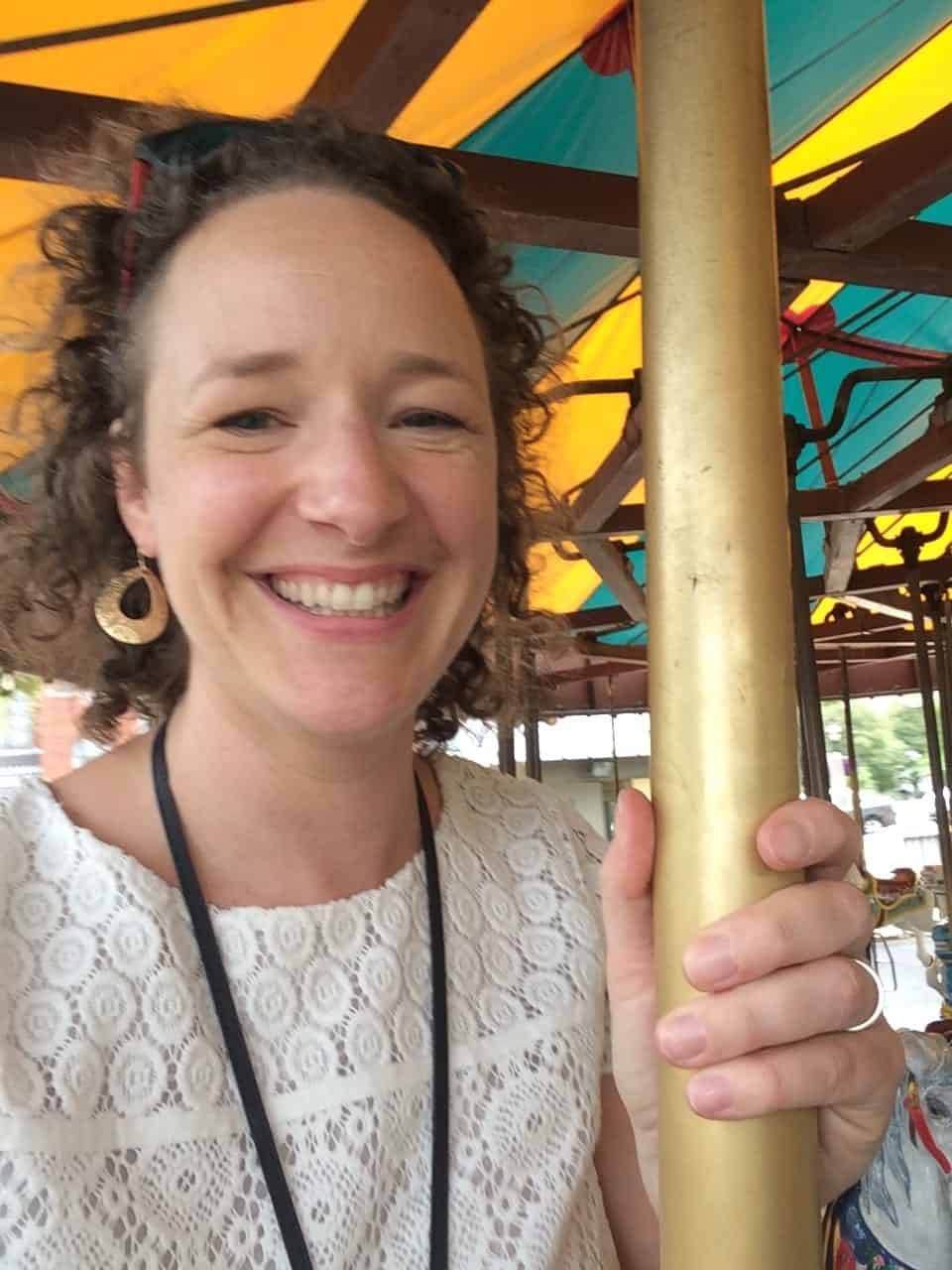This Self Guided Paris Tour explores the remnants of France's great and terrible kings along the banks of the river Seine. For entrance into many of the sites included below, do consider a tourist discount pass "The Paris Pass"

This inner courtyard is the oldest part of the Louvre. The Louvre was originally built in the 12th century by King Philip II, parts of the original building can still be seen in the crypt. It was transformed into a royal palace 300 years later by Charles V, and would remain the official royal residence until King Louis XIV moved the court to Versailles.
Of course, when each new king came into power, he wanted to leave his own mark on the city of Paris and the palace of the Louvre, so the building was pretty much constantly under construction. If you look around at the walls, you’ll notice little letters are carved everywhere. These are the insignias of the king that built that section, marking his territory for eternity.
Stop B: Pyramids of the Louvre

The Pyramids themselves were commissioned in 1984 by French president François Mitterrand, part of a series of projects to bring modern monuments to Paris. Designed by the architect I. M. Pei, the idea was to juxtapose the old style architecture (the building of the Louvre) with modern design of the Pyramids. When they were complete in 1989, many Parisians hated the Pyramids thinking they were far too modern, and ruined the majesty of the Louvre. Today, whether you love or hate them, the Pyramids have become iconic, and many wouldn’t recognize the Louvre without them.
Stop C: Secret Entrance to the Louvre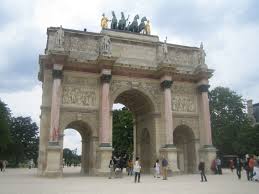
Many times, especially in summer, the line for the Louvre can wind through both inner courtyards, but there are several secret entrances. Through the glass doors beneath this arch, go down the escalators which lead to a shopping mall called Carrousel du Louvre. If you walk through the mall, underneath the inverted pyramid, you'll see a security check to get into the Louvre. There may be a line here, but it is always much shorter than at the main entrance.
The Louvre is open every day of the week except Tuesdays. It normally costs 15euros to get in, but children under 18, and European citizens under the age of 25 get in free with proof of age. It is also free on the first Sunday of every month between October and March, but this is not coincidentally the busiest day of the month as well, so be prepared to brave the crowds if you go then.
You can also skip the lines of the Louvre using the Fast Past Entry included on The Paris Pass.
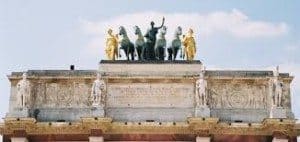
This arch is less famous than the larger Arc de Triomphe, which is a the top of the Champs Elysee, but they were both commissioned by the same person. This one was built between 1806-1808 by Napoleon, to celebrate his military victories. He, like many rulers, loved constructing big monuments to his own glory
On top of the Arc is a chariot which may be familiar to you, as it is the replica of the one on top of the Brandenburg Gate in Berlin. Originally the Arc was topped by the famous horses of St Mark’s Cathedral in Venice, which Napoleon had stolen during his conquest of Italy. When he was defeated at the Battle of Waterloo, he was required to return many of the stolen goods. The chariot that currently sits atop the Arc was commissioned in 1828 to celebrate the return of the Bourbon rulers.
Stop E: Palais de Tuileries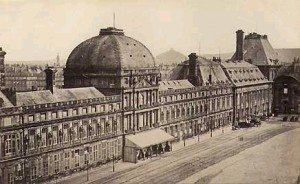
If you look around, you will notice that you're standing in the center of a large sandy rectangle. Today this outline is all that remains of a former royal palace, called the Palais des Tuileries, named after the tile kilns (Tuileries) that stood here before. It was built by Catherine de Medici in 1564 after the death of her beloved husband King Henri II, so she would no longer have to walk the same halls he had. It served as the royal residence often, lastly by King Louis XVI and his family, who were kept prisoner in the palace while they awaited trial and then execution during the French Revolution.
Almost 100 years later another revolutionary government, the short-lived Paris Commune was founded. This radically socialist government was lead by the people and based around the idea that Paris should govern itself as a city-state. The Commune also hated all signs of France’s former monarchy, so on May 23, 1871 they attacked the building that symbolized heart of the monarchy itself: the Louvre. Both the Louvre and the Palais des Tuileries were set on fire. Thankfully the Louvre was saved and repaired, but the Tuileries burned to the ground never to be rebuilt.
Stop F: Jardin des Tuileries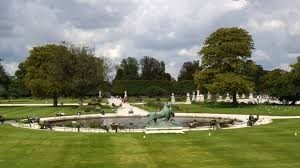
These gardens were originally built by Catherine de Medici in 1564, at the same time as the Palais des Tuileries. In those days Paris was a crowded and dirty city, so these gardens were meant to be a refuge, mimicking the gardens of Florence of Catherine’s youth. At the time, this was the biggest green space in all of Paris, and was also used to host lavish parties.
The layout of the gardens that we see today was designed by Louis XIV's legendary gardener Andre Le Notre in 1664. If you're unable to visit Versailles on your trip in Paris, consider this a preview of what the world-famous gardens are like. Louis XIV was an absolute ruler, and he used the designs of his gardens to show this. As you walk through this park, you'll see how each immaculately manicured flower bed is just so, and all of the trees are carefully trimmed into meticulous shapes. Louis XIV wanted to prove he controlled everything in France, even nature itself.
After the Revolution, the park was completely opened to the public and declared the National Park of the French Republic. Today it is one of the most fashionable parks in Paris. It is considered an outdoor extension of the Louvre and contains many beautiful statues, as well as temporary exhibitions throughout the year. Around Fashion Week in particular, the park is crawling with models, fashion shows and photographers, so keep an eye out, you never know who you might see.
Stop G: View of the Eiffel Tower
This terrace offers one of the best views of the world’s most iconic building available. The Eiffel Tower was built for the 1889 World’s Fair. Paris was hosting this event on the 100th anniversary of the Revolution, and they wanted to prove how far the Republic had come from the crazy, bloody days of the Revolution. It was decided that the best way to do this would be to build something very tall.
The tower was officially opened on May 6, 1889, and it was an immediate success with visitors. In spite of the fact the elevators were not yet functional, tens of thousands of people climbed the steps of the tallest building in the world. At 1063 feet (324 meters), the Eiffel Tower would remain the tallest building in the world for 41 years.
Although today it would be impossible to imagine Paris without the Eiffel Tower, when it was first completed many Parisians thought it was terribly ugly, an iron monster. These days, over 100 years later, it is pretty much universally loved. For more information on the Eiffel Tower and how to visit it, check out our blog post: https://freetoursbyfoot.com/visiting-eiffel-tower/.
Stop H: Place de la Concorde
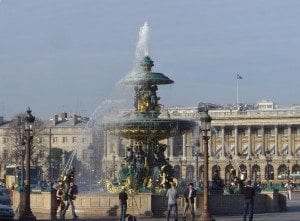
This was also where the unlucky Marie Antoinette met her end. Although she was given a trial, I was a total sham. She was accused of holding orgies, embezzling, and even abusing her own children, none of which were true. Marie Antoinette was executed on October 16, 1793. Her last words were reportedly “Pardon me sir, I did not mean it” after she accidentally stepped on a man’s foot on her way to the guillotine.
Fittingly, this is where Maximilien Robespierre, one of the main perpetrators of the Reign of Terror, was executed as well. When he heard that men were coming to arrest him on July 27, 1794, he attempted to commit suicide but only succeeded in shooting himself in the jaw. Robespierre spent his last night on a table in great pain and unable to speak. The next day he, along with some of his biggest supporters, were executed in the Place de la Revolution bringing an end to the Reign of Terror. Today the name Place de la Concorde means square of the peace pact, to try to make amends for its bloody past.
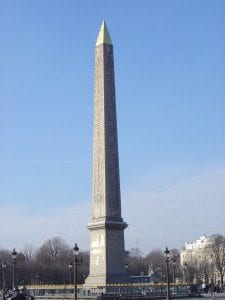
Where the guillotine once stood, in the center of the square is now an ancient Egyptian Obelisk. The Luxor Obelisk is over 3300 years old, making it the oldest monument in Paris. It originally stood with its twin outside the Luxor temple, but was gifted to France by the viceroy of Egypt in 1832. The twin still stands in Luxor to this day.
Because the Obelisk weighs over 551,000 pounds (250 metric tons), getting it from Egypt to Paris was an incredible feat of 19th century engineering. The engineers were so proud of their accomplishment, that they placed little diagrams explaining how they did it all around the pedestal.
Stop J: View of the Arc de Triomphe
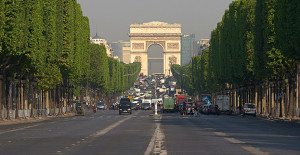
Underneath the arch is the Tomb of the Unknown Soldier. A soldier from World War I was interred here in 1919, and is honored for all those soldiers who died for their country in both world wars, but were never identified. By the tomb is the Eternal Flame, which burns continuously in memory of those soldiers.
You can also visit inside the Arc de Triomphe. It is open from 10h-23h (11pm) (April-September) or 2230h (1030pm) (October-March). Tickets are around 8 € for an adult. Children under 17 are FREE, as are visitors with the Paris Pass.
Stop K: Avenue des Champs-Élysées
The name Champs-Élysées translates to Elysian Fields, the ancient Greek idea of Heaven. This street was first called the Avenue des Champs-Élysées in Catherine de Medici’s time, because it lead to her heavenly garden, the Jardin des Tuileries. This is also when it was established as a fashionable street, as merchants used to gather along here hoping that the queen and her court would come buy their wares, particularly clothing. For a long time it remained the epicenter of Paris fashion, but today most fashionable people do their shopping in the trendy Marais instead.
This street makes up a significant portion of what the French call the Historic Axis, a perfectly straight line of monuments stretching from the Arch of La Defense in the suburbs, through the Arc de Triomphe, down the Champs-Élysées, past the Obelisk, into the Jardin des Tuileries, and ending at the Arc de Triomphe du Carrousel. The Bastille Day parade comes down this path, as have many armies throughout the years. This is also the last leg of the Tour de France.
Stop L: Grand and Petit Palais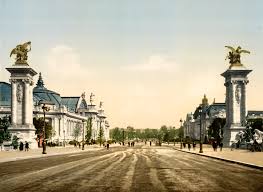
Both of these museums were built for the Universal Exposition of 1900. The Petit Palais specializes in art, particularly Renaissance paintings. Each room is carefully designed to bring out the best in whatever form of art is being displayed, from paintings to sculptures to porcelain or tapestries. There is also a very lovely courtyard at the center with a cafe, which can be a nice refuge from the busy streets of Paris.
The Grand Palais has hosted a wide variety of exhibitions, from fashion shows to household appliance displays, once even a human zoo. Thankfully those days are firmly in the past. Even if you are not interested in any of the current exhibitions at the Grand Palais it's worth going in just to gawk at the architecture. It is in the Beaux-Arts style which combines classical elements like columns with modern engineering of iron and glass.
Stop M: Pont Alexandre III
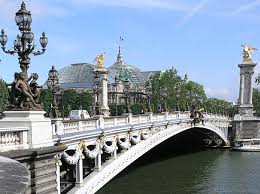
It is commonly acknowledged to be the most beautiful bridge in Paris, and is certainly the most ornate. Built in the Beaux-Arts style to match the neighbouring Grand Palais, it has beautiful Art Nouveau details.
Stop N: Les Invalides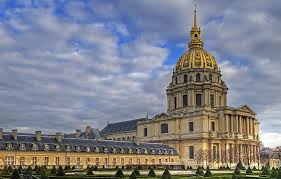
The full name of this beautiful building is L'Hôtel national des Invalides, which translates to the National Residence of the Cripples. This name stems from its original purpose, built by King Louis XIV in the 1600s. All of the wars of the famously bellicose Louis XIV had created a large population of invalid veterans, and without social support these men quickly became a huge problem in Paris. The crime and homelessness rates spiked, so in what was a very forward thinking move, King Louis built the retirement home of Les Invalides.
While it does still function partially as a retirement home, only a small number of people meet the requirement of 20 years of service these days, so most of the building is dedicated to the Museum of the Army. This is a great alternative if you’ve already visited some of Paris’ many art museums, or art is not of interest to you. The great dome is also the final resting place of one of France’s greatest and most terrible leaders, Napoleon Bonaparte.






